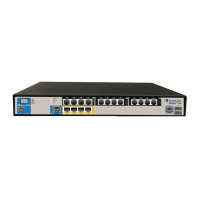Version 7.2 545 Mediant 800B Gateway & E-SBC
User's Manual 24. Routing
Typically, the device performs alternative routing when there is no response at all to an
INVITE message. This is done after a user-defined number of INVITE re-transmissions,
configured by the SIPMaxRtx parameter. In such a scenario, the device issues itself the
SIP response code 408 (Request Timeout). You can also configure the device to perform
alternative routing for the following proprietary response codes that are issued by the
device itself:
805 IP Profile Call Limit: The device generates this response code when Call
Admission Control (CAC) limits are exceeded for an IP Group. The CAC rules are
configured in the IP Profiles table (see 'Configuring IP Profiles' on page
436). When
this occurs, the device sends a SIP 480 (Temporarily Unavailable) response to the
SIP entity.
806 Media Limits Exceeded: The device generates this response code when the call
is terminated due to crossed thresholds of QoE metrics such as MOS, packet delay,
and packet loss (configured in the Quality of Experience Profile table) and/or media
bandwidth (configured in the Bandwidth profile table). When this occurs, the device
sends a SIP 480 (Temporarily Unavailable) response to the SIP entity. This is
configured by 1) assigning an IP Group a QoE and/or Bandwidth profile that rejects
calls if the threshold is crossed, 2) configuring 806 in the Reasons for Tel-to-IP
Alternative Routing table and 3) configuring an alternative routing rule.
Note: The device also plays a tone to the endpoint whenever an alternative route is
used. This tone is played for a user-
defined time, configured by the
AltRoutingToneDuration parameter.
Depending on configuration, alternative routing is done using one of the following
configuration entities:
Tel-to-IP Routing Rules: Alternative routing rules can be configured for a specific
routing rule in the Tel-to-IP Routing table. If the destination of the "main" routing rule is
unavailable, the device searches the table for the next matching rule (e.g., destination
phone number), and if available attempts to re-route the call to the IP destination
configured for this alternative routing rule. For more information on configuring
alternative Tel-to-IP routing rules, see 'Configuring Tel-to-IP Routing Rules' on page
525. The table below shows an example of alternative routing where the device uses
the first available alternative routing rule to re-route the initial, unsuccessful Tel-to-IP
call destination.
Table 24-7: Alternative Routing based on SIP Response Code Example
Destination
Phone Prefix
IP Destination SIP Response Rule Used?
Main Route
40 10.33.45.68
408 Request
Timeout
No
Alternative Route #1
40 10.33.45.70 486 Busy Here No
Alternative Route #2
40 10.33.45.72 200 OK Yes
Proxy Sets: Proxy Sets are used for Server-type IP Groups (e.g., an IP PBX or
proxy), which define the address (IP address or FQDN) of the server (see 'Configuring
Proxy Sets' on page
380). As you can configure multiple IP destinations per Proxy Set,
the device supports proxy redundancy, which works together with the alternative
routing feature. If the destination of a routing rule in the Tel-to-IP Routing table is an IP
Group, the device routes the call to the IP destination configured for the Proxy Set
associated with the IP Group. If the first IP destination of the Proxy Set is unavailable,

